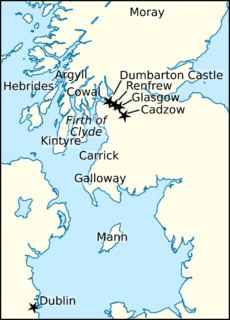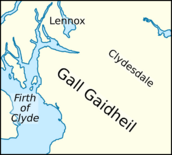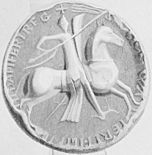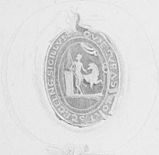Battle of Renfrew facts for kids
Quick facts for kids Battle of Renfrew |
|||||||
|---|---|---|---|---|---|---|---|
|
|||||||
| Belligerents | |||||||
| Kingdom of the Isles Kingdom of Dublin |
Kingdom of Scotland | ||||||
| Commanders and leaders | |||||||
| Somairle mac Gilla Brigte, King of the Isles † |
|
||||||
| Strength | |||||||
| 160 ships (possibly 6000–8000 men) | local levies? | ||||||
The Battle of Renfrew was a fight between the Kingdom of the Isles and the Kingdom of Scotland in 1164. It happened near Renfrew, Scotland. The forces from the Isles, joined by fighters from Dublin, were led by Somairle mac Gilla Brigte, King of the Isles. We don't know who led the Scottish side. Possible leaders were Herbert, Bishop of Glasgow, Baldwin, Sheriff of Lanark/Clydesdale, and Walter fitz Alan, Steward of Scotland.
This battle was a big defeat for Somairle's forces. Somairle himself was killed, probably by local Scottish fighters. His army was completely defeated.
Somairle first appears in history in the 1150s. He supported Máel Coluim mac Alasdair in a rebellion against Malcolm IV, King of Scotland. Máel Coluim was from a different branch of the Scottish royal family. His sons were related to Somairle. After this rebellion failed, Somairle focused his efforts on the Isles. In 1156, he took about half of the Kingdom of the Isles from his brother-in-law, Guðrøðr Óláfsson, King of the Isles. Two years later, Somairle defeated Guðrøðr completely and took full control of the kingdom.
The exact reasons for Somairle's attack on Scotland are not clear. One idea is that he was again trying to help Máel Coluim's sons. Another idea is that he wanted to conquer the southwest part of Scotland. This area might have only recently come under Scottish control. This region was once home to the Gall Gaidheil, who were a mix of Scandinavian and Gaelic people, just like Somairle. It's thought that Scotland gained control of this area after Máel Coluim's rebellion failed. Then, powerful Scottish lords were given parts of this land. Somairle might also have invaded because he felt the Scots were a threat to his power in the Firth of Clyde. The battle happened at Renfrew, which was a main area for Walter fitz Alan. This could mean Walter was a specific target.
After Somairle died in the battle, the Kingdom of the Isles split up again. Guðrøðr's brother, Rǫgnvaldr, took power for a short time. But Guðrøðr quickly defeated him. Once Guðrøðr was back in charge, the kingdom was divided again. This time, it was split between him and Somairle's family, following the way Somairle had taken power in 1156. The Battle of Renfrew might have been Malcolm IV's greatest victory. It is certainly the last major event recorded during his time as king.
Contents
Why the Battle Happened
Around the mid-1100s, perhaps in 1140, Somairle mac Gilla Brigte married Ragnhildr. She was the daughter of Óláfr Guðrøðarson, King of the Isles. This marriage was very important for the future of the Kingdom of the Isles. It gave Somairle's family, known as Clann Somairle, a claim to be kings because Ragnhildr was from the royal family.
The year 1153 was a turning point for the Isles. Not only did David I, King of Scotland die, but Óláfr was also killed in June. His son, Guðrøðr, was away in Norway at the time. Within months, Guðrøðr returned to get revenge. He traveled from Norway to Orkney with Norwegian soldiers. The main leaders of the Isles then chose him as king. He then went to the Isle of Man. There, he defeated three cousins who had killed his father, and he secured his kingship.
In 1155 or 1156, Somairle took power from Guðrøðr. He put his own son, Dubgall, in charge instead of Guðrøðr. In late 1156, Somairle and Guðrøðr fought a fierce but undecided sea battle. After the battle, the two men divided the Kingdom of the Isles between them. Two years later, Somairle invaded the Isle of Man. He drove Guðrøðr out of the kingdom and into exile. With Guðrøðr gone, it seems either Dubgall or Somairle became King of the Isles. Even though young Dubgall might have been the official king, Somairle held the real power. Irish records certainly called Somairle a king by the end of his life.
The Battle Itself
Many old writings tell us about the Battle of Renfrew. These include the Annals of Tigernach, the Annals of Ulster, and the Chronicle of Mann.
The Chronicle of Melrose says that Somairle's forces came "from Ireland and various places." Irish records add that his army included men from Argyll, Kintyre, the Isles, and Dublin. This shows how much power Somairle had at his strongest. The invasion was clearly well-planned. Somairle's invasion fleet had 160 ships. If each ship carried 40 to 50 fighters, Somairle might have had between 6,000 and 8,000 men. Even though numbers from medieval times can be exaggerated, they give us an idea of how big the army was. The fact that Dubliners joined Somairle suggests he had an alliance with them. He might have had an agreement with Dublin's ruler, Diarmait Mac Murchada, King of Leinster, or with Diarmait's own overlord, Muirchertach Mac Lochlainn, High King of Ireland.

According to the Chronicle of Mann and the Chronicle of Melrose, Somairle's fleet landed at Renfrew. It's possible they landed specifically at Inchinnan. There, his forces might have first met the Scots. The battle was a disaster for the Islesmen. Their king, Somairle, was killed in a fight against local Scottish fighters. One account says Somairle was killed early in the battle, "wounded by spear, slain by the sword." He was overcome by a quickly put-together group of local defenders. So, Somairle might have fallen at the very beginning, and his leaderless followers then gave up the fight. This account also says that Somairle's head was cut off by a priest and given to Herbert, Bishop of Glasgow. Another source says Somairle was killed with a son named Gilla Coluim. It's not known if Dubgall, Somairle's other son, was in the battle.
The fact that the battle happened at Renfrew suggests that Walter fitz Alan, Steward of Scotland was the target. Walter owned Renfrew during his time, and it might have been the main place for his lands. The leader of the Scottish forces is not certain. It could have been one of the three main men of the region: Herbert, Baldwin, Sheriff of Lanark/Clydesdale, or Walter. While Somairle might have focused his attack on Walter's lands at Renfrew, it's also possible that Herbert, as Malcolm's representative in the west, was the intended target. One account links Herbert to the victory and doesn't mention Walter or any Scottish royal forces. However, Baldwin's nearby lands were passed by Somairle's ships. This suggests that Baldwin or his followers fought and defeated the invaders. In any case, the victory over the Islesmen and their allies brought peace to Scotland for the rest of Malcolm's rule. It may have been Malcolm's greatest victory.
Historical Setting

Somairle's rise to power seems to have happened as the Scottish king's power in Argyll became weaker. This outside influence in Argyll can be seen in Scottish royal documents. For example, a royal document from 1141–1147 shows that King David I gave some of his cáin (a type of tribute or revenue) from Argyll and Kintyre to Holyrood Abbey. Another document from 1145–1153 shows the king giving some of his cáin from Argyll to Urquhart Priory. Later, in 1150–1152, David gave more of his cáin in Argyll and Kintyre to Dunfermline Abbey. The fact that this document says "in whatever year I should receive it" might mean that between 1141 and 1152, the Scottish Crown lost control of these areas to Somairle. Even though David might have seen Argyll as a Scottish territory that paid tribute, Somairle's later actions clearly show that he saw himself as a completely independent ruler.
Somairle is first mentioned in 1153. The Chronicle of Holyrood says he supported his "nepotes" (possibly nephews or grandsons) in a failed attempt to take power after David's death. These "nepotes" were the sons of Máel Coluim mac Alasdair, who also claimed the Scottish throne. He was a descendant of David's older brother, Alexander I, King of Scotland. Some of the fighting by Somairle and the Meic Máel Coluim is also mentioned in another writing. It talks about him damaging Glasgow, its cathedral, and the surrounding countryside. After this uprising failed, Somairle seems to have left the Meic Máel Coluim. He then turned his attention to the Isles. By Christmas 1160, a Scottish royal document shows that Somairle had made peace with Malcolm IV earlier that year. However, four years later, Somairle launched his final invasion of Scotland. It's possible he did this to support Máel Coluim's claim to the Scottish throne again.
Another reason for Somairle's invasion could be that he was trying to secure an area that the Scottish Crown had only recently taken control of. Although there are no records of Somairle before 1153, his family was involved in an earlier uprising by Máel Coluim against David I. That uprising ended with Máel Coluim being captured in 1134. A result of this failed rebellion can be seen in a Scottish royal document from around 1136. This document shows the Scottish Crown's claim to cáin in Carrick, Kyle, Cunningham, and Strathgryfe. Historically, this region seems to have been part of the territory controlled by the Gall Gaidheil, a people of mixed Scandinavian and Gaelic background. One idea is that these lands were part of a Gall Gaidheil kingdom before the Scottish Crown defeated Máel Coluim and his supporters. This document also mentions Fergus, Lord of Galloway, a powerful Scandinavian-Gaelic lord who held lands in Carrick. Fergus being mentioned could mean that while Somairle's family might have lost power after Máel Coluim's defeat, Fergus and his family might have gained from supporting David. Fergus being among the Scottish elite shows that David's royal power was growing in the 1130s.
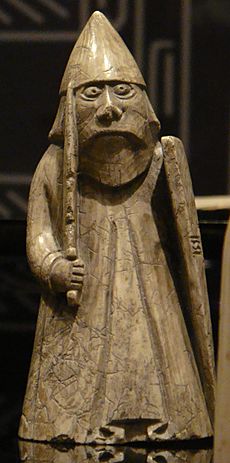
Walter fitz Alan is another important figure first mentioned in these documents. He might have been given the lands of Strathgryfe, Renfrew, and North Kyle when David granted the cáin. One explanation for Somairle's invasion is that he felt he had to fight against a threat from Walter and other Scottish lords who had recently been given lands. The power vacuum left by Óláfr's death might have caused this conflict. While the uncertainty after Óláfr's death was a threat to the Scots, the growing Scottish power along the western coast, especially with Walter's large land grants, meant the Scots could also take advantage of the situation. In fact, it's thought that during Malcolm's reign, Walter began to extend his own power into the Firth of Clyde, the islands of the Clyde, and parts of Argyll.
The giving out of Scottish lands along the western coast suggests these lands were settled to defend Scotland from threats from Galloway and the Isles. This is likely why important western lordships were given to men like Hugh de Morville, Constable of Scotland, Robert de Brus I, and Walter himself. So, the mid-1100s saw a steady increase in Scottish power along the western coast by some of the kingdom's most powerful lords. These lords could have moved into Somairle's area of influence. The continuous expansion of Scottish power might have pushed Somairle to launch a counter-attack. It's possible that Somairle first took control of the islands of the Firth of Clyde after his 1156 battle with Guðrøðr. By doing so, Somairle gained control of islands in an area that the Scots saw as very important for their own safety. In fact, the reason for building Scottish castles along the River Clyde might have been the potential threat from Somairle.
Somairle's last campaign seems similar to later Norwegian-backed invasions of the Firth of Clyde by his descendants in the 1200s. Another reason that might have pushed Somairle to attack the Scots could have been Malcolm's worsening health. The Chronicle of Melrose says that the Scottish king was very sick in 1163, and he might never have fully recovered. One idea is that Somairle saw the king's illness as an opportunity. He might have thought Scottish royal power was weakening.
What Happened Next
Even though Somairle's son Dubgall might have taken power after his father died, the Chronicle of Mann shows that Guðrøðr's brother, Rǫgnvaldr, soon took over the kingship of Mann. But before the end of the year, Guðrøðr arrived in the Isles and quickly defeated his brother. Guðrøðr then became king again. The kingdom was divided between him and Clann Somairle, following the way Somairle had taken power in 1156. While there's no direct proof that Somairle's empire broke apart after his death, it's likely it was divided among his sons. In the years after Somairle's death, there's evidence that Walter and his family took advantage of the known fighting among Somairle's descendants.
Queen Blearie's Stone
There are several local stories about where the battle took place. One story from the late 1700s says that the invaders landed at Renfrew. They then marched south to Knock, a raised area between Renfrew and Glasgow. There, they were defeated by local forces. In 1772, Thomas Pennant visited this site. He saw "a mount or tumulus (a small hill), with a ditch around its base, and a single stone on the top." He was told this marked the spot where Somairle was defeated.
Older stories about this monument called it "Queen Blearie's Stone." They linked it to the death of Marjorie Bruce and the birth by C-section of her son, Robert II, King of Scotland. Pennant's story might have been influenced by David Dalrymple, Lord Hailes. Dalrymple suggested that "Queen Blearie's Stone" might be a hidden Gaelic name, Cuiné Blair, meaning "Memorial of Battle." This name would refer to the Battle of Renfrew. If the monument was indeed connected to the battle, it could be the pillar shown on Walter's seal. If so, the seal's picture of a man leaning against a pillar could celebrate the Scottish victory. In any case, "Queen Blearie's Stone" was destroyed before the end of the 1700s. Part of it was used as a lintel (a beam above a door) for a barn. By the mid-1800s, it had disappeared completely. The approximate site of "Queen Blearie's Stone" (grid reference NS 4932 6614) is now part of a housing estate.


